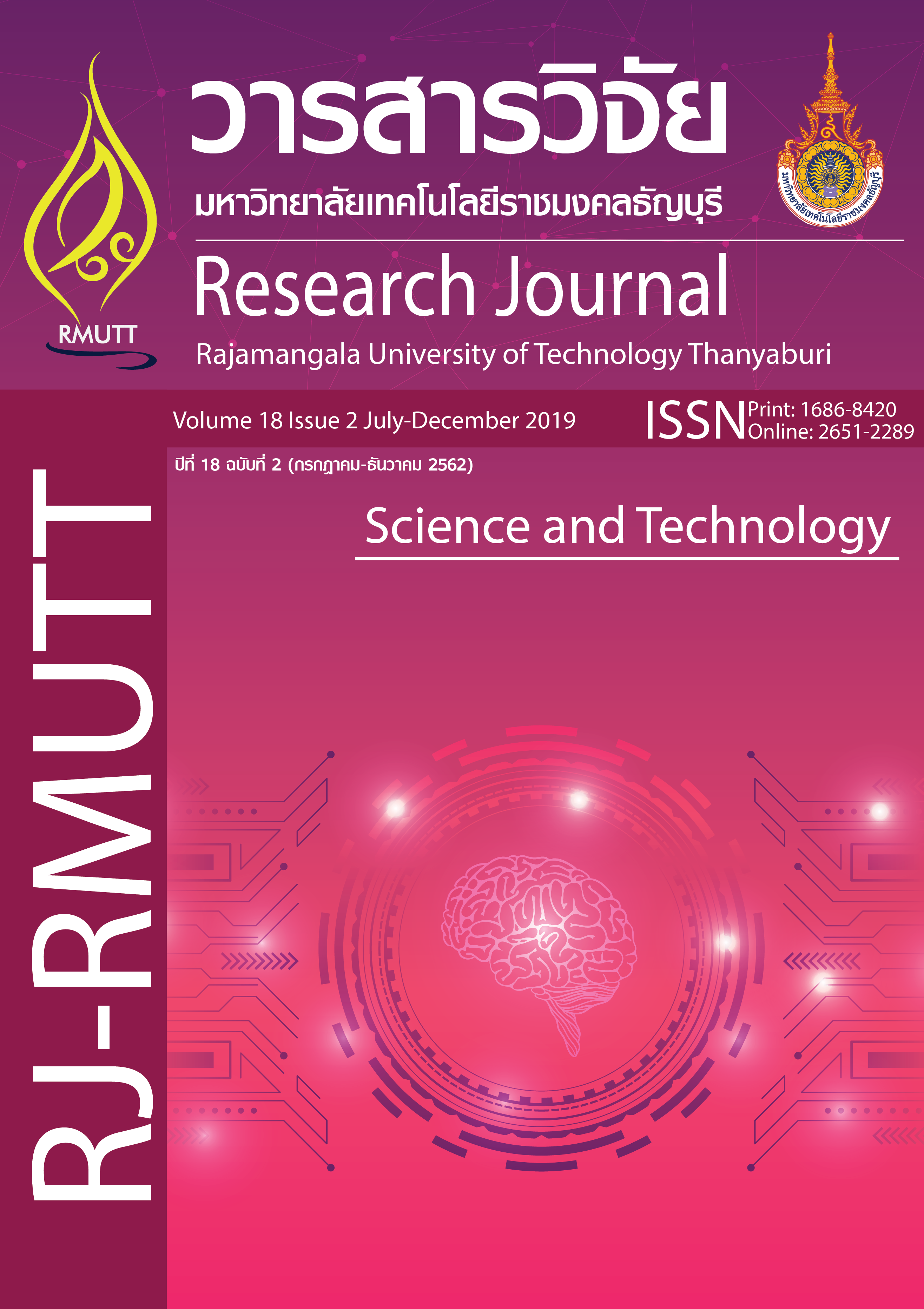Testing and Evaluation of Rice Milling Machine Based on Thai Industrial Standard
Main Article Content
Abstract
Testing and evaluation of rice milling machine based on Thai Industrial Standards (TIS) was aimed to study the system components of a rice mill, test the performance and efficiency of rice milling machines, analyze the economics cost and suggest for the improvement of rice mill operation. Eight rice mills were selected namely 1. Banthongkuem Rice Mill 2. Bangbungtake Community Enterprise Rice Mill 3. Jedeehak Community Center Rice Mill 4. Bansrichula Community Rice Mill 5. Bungkasam Rice Mill 6. Bankomailai Community Center Rice Mill 7. Phromchaiphatthana Community Rice Mill and 8. Banyoihai Community Rice Mill. The study parameters were the milling rice recovery, the head rice recovery, the percentage of polishing, the percentage of whole grains; and the milling capacity. The research study was conducted based on Thai Industrial Standards 888-2532. According to the testing and evaluation of rice milling machines, the milling capacity varied between 0.08-0.5 tons of paddy per hour. The milling rice recovery and the head rice recovery ranged between 65-93 percent and 50-71 percent, respectively. These parameters were higher than Thai Industrial Standards. The economics cost analysis showed that the breakeven points of the eight rice mills were 145, 168, 72, 187, 140, 30, 64 and 28 tons of paddy per year, respectively. Considering the contract rate of 200 baht per hour, the payback periods were 5.4, 4.3, 2.8, 5.3, 2.8, 2.4, 3.3 and 1.2 year, respectively.
Article Details

This work is licensed under a Creative Commons Attribution-NonCommercial-NoDerivatives 4.0 International License.
References
กรมการค้าต่างประเทศ กระทรวงพาณิชย์. สถานการณ์การส่งออกข้าว [อินเทอร์เน็ต]. 2562; [สืบค้นเมื่อวันที่ 28 มิ.ย. 2562]. จาก: https://mgronline.com/business/detail
จินดามณี นิสยันต์, อภิชาติ อาจนาเสียว. การเพิ่มประสิทธิภาพโรงสีข้าวหอมมะลิ. ใน: การประชุมวิชาการเสนอผลงานวิจัยระดับบัณฑิตศึกษา ครั้งที่ 12; 28 ม.ค. 2554; มหาวิทยาลัยขอนแก่น. น. 328-36.
อภินันท์ ใจกว้าง, สมบูรณ์ สารสิทธิ์, ธนาภรณ์ เมืองมุงคุณ. การสร้างและทดสอบเครื่องสีข้าวกล้อง ชุมชนชนิดลูกยางคู่. วารสารมหาวิทยาลัยราชภัฏมหาสารคาม. พ.ค.-ส.ค. 2553;4(2):9-15.
กรมโรงงานอุตสาหกรรม กระทรวงอุตสาหกรรม. หลักปฏิบัติเทคโนโลยีการผลิตที่สะอาด (การเพิ่มประสิทธิภาพการผลิตและการป้องกันมลพิษ) [อินเทอร์เน็ต]. 2549; [สืบค้นเมื่อวันที่ 1 ก.ค. 2562]. จาก: http://php.diw.go.th/ctu/files/pdf
Rice Knowledge Bank. Milling and Processing [อินเทอร์เน็ต]. [สืบค้นเมื่อวันที่ 5 ก.ค. 2562]. จาก: http://www.knowledgebank.irri.org/
step-by-step-production/postharvest/milling
สำนักงานมาตรฐานผลิตภัณฑ์อุตสาหกรรม กระทรวงอุตสาหกรรม. มาตรฐานผลิตภัณฑ์อุตสาหกรรม เครื่องสีข้าวขนาดเล็ก มอก. 888-2532. 2532. น.
-100.
Omer Badi 2013. Rice Quality. Rice Post-Harvest Technology Training Program [อินเทอร์เน็ต]. สถานที่พิมพ์: Japan International Cooperation Agency (JICA); 2556; [สืบค้นเมื่อวันที่ 1 ก.ค. 2562]. จาก: https://www.jica.go.jp/project/english/
Operating Manual. Grain Moisture Tester PM-450 (Version 4501) [อินเทอร์เน็ต]. [สืบค้นเมื่อวันที่ 1 ก.ค. 2562]. จาก: http://www.kett.co.jp/data
/e_files/pm450_4501_manual_e_rev0101_web_201709061441.pdf
Hunt D. Farm Power and Machinery Management. 10th ed. Ames, Iowa, USA: Iowa State University Press; 2001. p. 360.
กระทรวงแรงงาน. สถาบันความปลอดภัยในการทำงาน กรมสวัสดิการและคุ้มครองแรงงาน [อินเตอร์เน็ต]. [สืบค้นเมื่อวันที่ 1 ก.ค. 2562]. จาก: https://www.si.mahidol.ac.th/th/division/ophs/admin/knowledges_files/14_34_1.pdf


